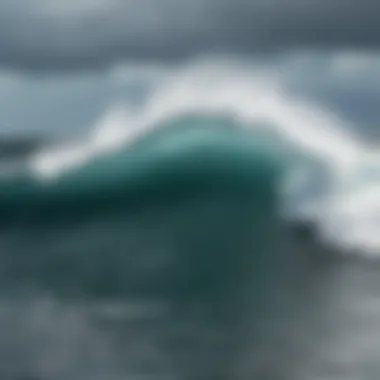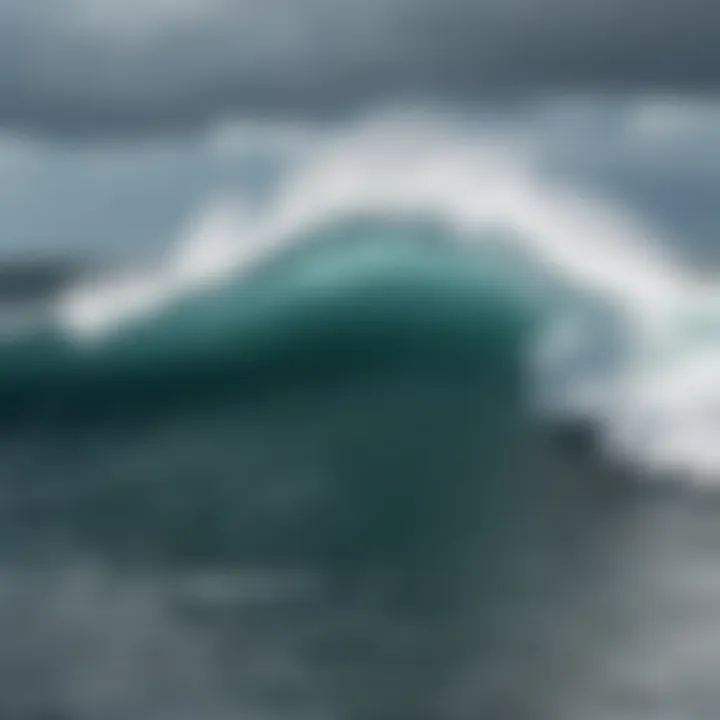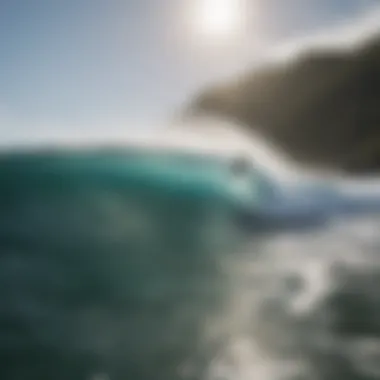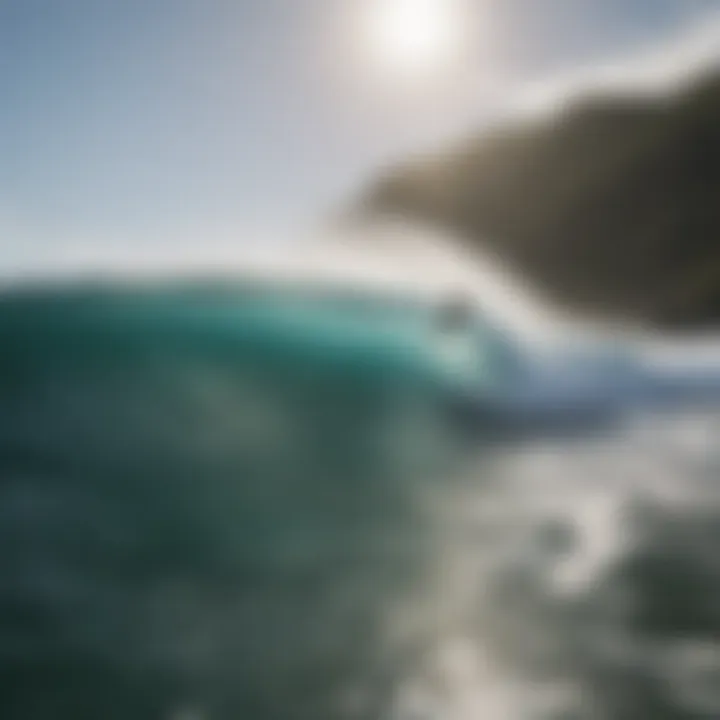Understanding Surf Radar: A Guide for Watersport Enthusiasts


Intro
As the surf culture continues to grow, so too does the technology that empowers it. Surf radar is an essential tool that can transform how one interacts with the ocean. This guide aims to delve into the world of surf radar, shedding light on its mechanics, advantages, and practical applications. Whether you're carving through a mellow swell or tackling heavy waves, understanding surf radar can significantly enhance your experience.
Utilizing this technology allows both recreational and competitive surfers to read the ocean with greater precision. Increased awareness of surf conditions not only translates to a more enjoyable session but can also mean the difference between a fun day out and a risky encounter with unpredictable waters. By the end of this article, you’ll grasp how surf radar operates, its limitations, and the best gear to support your surfing endeavors.
Gear Recommendations
When it comes to engaging in watersports, the right equipment can make a world of difference. Whether you're just getting your feet wet or you're a seasoned pro, there’s gear tailored to meet your needs. Below, we assess essential items that will elevate your surfing experience.
Essential Gear for Beginners
Starting off in the surf can be overwhelming. Having the right basics sets you up for success. Here’s a rundown of must-have gear for newcomers:
- Surfboard: Choose a board suited for beginners. Soft-top boards offer flexibility and safety.
- Wetsuit: Depending on your surfing locale, a good wetsuit provides insulation and protection. Look for ones that fit snugly.
- Leash: This safety item keeps your board attached to you, preventing it from becoming a hazard to others.
- Surf Wax: Vital for grip, surf wax helps keep your feet planted as you ride.
Advanced Equipment for Professionals
For those looking to step up their game, investing in advanced gear can unlock new dimensions of performance:
- Performance Surfboard: Opt for a high-performance board designed for the conditions you surf in.
- Impact Vest: Adds an extra layer of safety, particularly in more challenging environments.
- Surf Radar Device: These gadgets offer real-time data about wave conditions, making it easier to choose the best times and locations to surf.
- Personal GPS Tracker: Safety first, this gear allows you to be located easily in emergencies.
Techniques and Tips
Mastering the waves requires not just the right gear but also effective techniques and sensible practices. Here’s how to sharpen your skill set and ensure safe outings.
Skill Improvement Strategies
Progressing in your surfing skills can take time and patience. Consider these strategies to enhance performance:
- Practice Regularly: Consistency breeds confidence.
- Film Your Sessions: Watching yourself ride can uncover areas for improvement.
- Surf with Others: Join a local group or community to share tips and learn from each other.
Safety Practices and Guidelines
Safety should never take a back seat while surfing. Adhering to guidelines can help avoid mishaps:
- Know the Locals: Every beach has its unique challenges and hazards.
- Understand Rip Currents: Learning how to identify and navigate rip currents is crucial.
- Surf Within Your Limits: Pushing boundaries is part of the thrill, but knowing when to back off is as important.
"Knowledge is power; understanding surf radar is like having an ocean-sized cheat sheet for your water adventures."
This guide aims not just to inform but to empower all surfers, from greenhorns eager to learn to veterans looking for an edge. The ocean is a vast playground, and with the right tools and knowledge, you're well on your way to mastering it.
Prolusion to Surf Radar
Surf radar plays a critical role in how watersport enthusiasts engage with the ocean. Understanding how this technology enhances the surfing experience is essential for anyone who spends time on the waves. Surf radar, at its core, provides real-time data about wave conditions, wind speeds, and even currents, enabling surfers to make well-informed choices about when and where to ride. It serves as a navigator’s best friend, providing insights that can significantly affect safety and performance.
In this guide, we will explore various aspects of surf radar technology, highlighting its significance in both recreational and competitive settings. Not only does it help surfers avoid dangerous conditions but it also plays a role in determining the best surf spots based on current weather patterns and oceanic activity.
Defining Surf Radar Technology
Surf radar technology utilizes electromagnetic waves to detect and measure characteristics of the surface of the ocean. By sending out signals and analyzing their reflections, surf radar can pinpoint wave height, frequency, and direction. This allows surfers to understand the conditions they might face and make strategic decisions about their surfing.
The technology breaks down into different systems, each tailored for specific applications, such as recreational surfing, safety monitoring, and competition analysis. Beyond just waves, surf radar can help gauge wind directions and speeds, providing a richer picture of the surfing environment. In doing so, it transforms the surfing experience into a well-informed adventure.
Historical Development of Surf Radar
The origins of surf radar trace back to the broader field of radar technology, which emerged during World War II for military applications. However, it didn’t take long for this technology to find its way into civilian use. The 1980s marked a turning point as universities and research organizations began to explore its potential for monitoring ocean conditions. Early adopters saw the value in these systems not just for scientific research, but also for practical applications in recreational activities.


With advancements in technology, surf radar has evolved significantly. The introduction of digital signal processing and increased computational power has made it more accurate and accessible. These developments have led to the creation of more compact and efficient radar systems that can be deployed along various coastlines. Today, surf radar is integral to local surf reports, offering an array of data points that surfers and beachgoers rely on.
As we dive deeper into the mechanics and importance of surf radar in later sections, it's clear that understanding its foundational elements enriches the experience for everyone on the water. By grasping where surf radar technology has come from and what it can do, surfers can better appreciate the tools available to them.
Mechanics of Surf Radar Systems
When it comes to grasping surf radar technology, understanding its mechanics is crucial. This section sheds light on how surf radar systems work, highlighting their components, benefits, and some essential considerations that every watersport enthusiast should keep in mind.
How Surf Radar Operates
At its core, surf radar operates on the principle of sending out radio waves and then interpreting the signals bounced back from the ocean surface. When these radio waves hit the water, they get reflected based on the surface movement, which includes factors like wave height and speed. The system calculates the time it takes for the waves to return, which allows users to gauge real-time surf conditions effectively.
This operation is not just a guesswork; it's a scientific process that offers precise data, allowing both surfers and lifeguards to make informed decisions on surf safety and enjoyment. As waves break or shift, the surf radar updates provide critical information on conditions that may be dangerous or ideal for surfing. If a surfer has this radar data at their fingertips, it can make a world of difference in having a safer experience on the water.
Components of a Surf Radar Setup
A complete surf radar system comprises several integral components that work in harmony to deliver accurate and real-time data. Let’s break these down for clarity.
Radar Antenna
The radar antenna is often seen as the heart of a surf radar setup. Its ability to emit and receive radar waves is paramount. Typically, antennas come in two varieties: S-band and X-band. The latter is a popular choice because it generally provides higher resolution data, crucial for observing fast-moving wave patterns.
One key characteristic of antennas is their coverage area. A well-placed antenna can monitor a large expanse of the coastline. However, despite being efficient, they do come with limitations. For example, structures like pier or tall buildings can obstruct signals.
A reliable radar antenna can significantly enhance the information available to surfers, transforming guesswork into data-driven decision-making.
Signal Processing Unit
Next up, we have the signal processing unit. This unit is essential because it takes the raw data received by the radar antenna and converts it into usable information. It's like the brain of the operation, analyzing and filtering noise from the signals to present coherent data.
What stands out about this component is its sophisticated algorithms that can differentiate between actual wave formations and other marine anomalies. A quality signal processing unit ensures that surfers are getting the most accurate information possible, which is vital in conditions where safety is paramount. However, not all units are created equally—some may lack the precision needed for critical environments. Therefore, choosing the right processing unit is crucial.
Data Display Systems
Lastly, the data display systems tie everything together. Without a clear visualization of the data processed, surfers would find it difficult to interpret the information provided by the radar setup. These systems range from simple screens showing wave height and period to more complex interfaces that integrate with smartphones or tablets.
One key characteristic is their user-friendly design, which allows surfers to extract relevant information quickly while on the go. Not all display systems, however, demonstrate real-time processing, which can be a disadvantage during rapidly changing ocean conditions.
In summary, each component of a surf radar system plays a specific role contributing to the overall functionality and reliability. By understanding how these systems operate and the critical characteristics of each part, surfers can make informed choices, significantly enhancing their surfing experience.
The Importance of Surf Radar in Surfing
Surf radar technology has emerged as a game-changer for surfers and watersport enthusiasts alike. Its significance extends beyond mere wave height measurements; it fundamentally enhances the surfing experience by providing real-time data and information crucial for decision making out on the water. With unpredictable surf conditions being the norm, the role of surf radar becomes all the more vital for safety, enjoyment, and performance.
Enhancing Safety Through Accurate Reporting
Safety is paramount when it comes to any sport, and surfing is no exception. One area where surf radar shines is in its ability to deliver accurate and timely reports regarding wave conditions and weather changes. This allows surfers to avoid dangerous situations such as sudden storms or crashing waves that may catch them off guard.
Surfers can receive alerts about changing conditions, as radar systems provide essential information regarding currents, wind direction, and overall surf height. Reliable data means that surfers can choose optimal times to hit the waves, ultimately decreasing the risk of accidents. To put it bluntly, having surf radar is akin to having a trusty weather forecaster right by your side, guiding you to make smart choices.
"Intelligence and information are your best tools when facing the ocean."
Surf Forecasting Helps Predict Conditions
The capability of surf radar systems to forecast conditions plays a major role in planning and enhancing a surfer's day. The technology enables a detailed analysis of incoming swells and real-time evaluations of existing surf conditions. This information is invaluable for choosing the right time and place for surfing, reducing the guesswork that often accompanies outdoor activities.
- Important advantages of surf forecasting include:


- Wave Height Predictions: Knowing when larger swells will arrive can mean the difference between catching a great wave or getting washed away.
- Currents and Wind: Understanding how currents will behave allows for better navigation. Surfers can position themselves advantageously based on wind direction and currents.
- Long-Term Projections: With continuous improvements in radar technology, surfers gain access to forecast data days in advance, helping them plan trips and maximize their time on the water.
In a world where uncertainties abound, having a surf radar signals a significant step towards more informed and confident surfing. As technology evolves, so too does our ability to read the waves, guaranteeing that our adventures on the water can be both safe and rewarding.
Limitations of Surf Radar Technology
Understanding the limitations of surf radar technology is crucial for anyone involved in watersports. While surf radar provides valuable insights into wave conditions and safety, it is not without its drawbacks. Recognizing these limitations allows surfers, instructors, and enthusiasts to complement radar data with other forms of observation and knowledge for a well-rounded experience on the water.
Environmental Factors Affecting Accuracy
Surf radar, though advanced, can be influenced by a myriad of environmental factors. These elements can distort signals and lead to inaccuracies. For instance:
- Sea State: Choppy waters can affect the radar's ability to detect and interpret wave formations accurately.
- Weather Conditions: Heavy rain, fog, or storms can hinder radar functionality, leading to less reliable data.
- Interference: Nearby structures or boats can create clutter on the radar screen, masking vital information about the surf conditions.
Surfers should thus be cautious when relying solely on radar data during such unfavourable weather states. It’s beneficial to check multiple sources and analyze current surf conditions on the day of an outing.
Comparative Analysis with Other Forecasting Methods
When examining surf forecasting tools, it’s important to position surf radar alongside other methods. While surf radar offers real-time data, it may not always be the most comprehensive solution. Here’s a quick look at how it stacks up:
- Buoy Reports: These devices collect data from specific locations, offering continuous monitoring of wave height and direction. Unlike surf radar, they provide localized information that accounts for variations across different spots.
- Satellite Imaging: This method allows for large area assessments, which can be useful for broader forecasts. It provides a stark contrast to radar’s more localized coverage, often missing rapid changes in smaller regions.
- Surf Forecasting Websites: Websites analyze data from multiple sources, including weather patterns and historical data, providing surfers with extensive predictive analytics. This makes them considerably useful in planning future sessions.
Ultimately, integrating surf radar data with these alternative forecasting methods can considerably enhance a surf session's overall safety and quality.
"Even the best technology has its flaws. As a surfer, understanding these limits can lead to making better decisions out on the water."
In summary, while surf radar is an invaluable resource for savvy water adventurers, being aware of its limitations enhances one’s ability to respond effectively to the ever-changing ocean environment. Surfers who combine surf radar insights with other forecasting techniques can navigate the waves with greater confidence.
Types of Surf Radar Available
Surf radar technology encompasses various systems tailored for diverse needs on the water. Understanding the types available is crucial for watersport enthusiasts seeking to enhance their experience while riding the waves. Each radar type offers unique benefits, tailored for specific conditions and applications. Making the right choice can significantly impact safety and enjoyment, furthing deeper engagement with surf conditions.
S-Band and X-Band Radar Systems
When considering surf radar systems, two primary types often come into play: S-Band and X-Band. Both have their strengths and weaknesses, making them suited for different applications.
S-Band Radar is typically used for long-range detection. Operating at frequencies of 2 to 4 GHz, S-Band systems can see waves further offshore, providing a comprehensive overview of surf conditions. This allows surfers to gauge conditions from a distance, potentially avoiding dangerous areas.
Some notable characteristics of S-Band radar include:
- Long Range: Effective for tracking large weather systems and wave patterns.
- Less Affected by Rain: Can operate better in moist conditions, providing consistent data.
On the flip side, X-Band Radar operates at a higher frequency range of 8 to 12 GHz, making it much better for short-range imaging. X-Band is particularly adept at providing detailed, real-time data on wave heights and breaks. Surfers who want instant feedback on changing conditions may lean towards X-Band systems. Its advantages include:
- High Resolution: Captures smaller waves and subtle changes in surf conditions.
- Quick Refresh Rates: Provides detailed updates for rapidly changing environments.
Both systems serve significant purposes, and surfers often choose based on specific needs.
Emerging Technologies in Surf Radar
The development of surf radar technology shows no signs of slowing down. Recently, innovations have paved the way for more effective and user-friendly systems, benefitting both competitive and recreational surfers.
One exciting area is the integration of software advancements with traditional radar systems. Enhanced algorithms process data faster, yielding real-time feedback with greater accuracy. By employing machine learning, systems can predict wave patterns based on historical data, offering surfers a clearer picture of future conditions.
Some notable innovations include:
- Mobile Applications: These apps provide surfers easy access to radar data on their smartphones, connecting them to local surf conditions while on the go.
- Remote Sensing Drones: Some setups now include aerial surveillance, providing ground-level views of surf conditions, enhancing radar data comprehension.
- Internet of Things (IoT) Integration: Advanced surf radar systems connect with other devices, contributing to a network that enhances awareness and safety in surf environments.


As technology continues to advance, the expectation is that surf radar will become more accessible and sophisticated. The future holds much promise, offering surfers unprecedented insights into their beloved sport.
Surf Radar and Competitive Surfing
The integration of surf radar technology in competitive surfing is reshaping the sport in significant ways. As competitions become more sophisticated, ensuring that surfers have access to the most accurate and timely data can give them an edge. From local contests to global events, understanding and utilizing surf radar improves not only safety but strategic decision-making.
Utilizing Surf Radar in Competitions
When it comes to competitive surfing, the stakes are high. Every wave can determine a victory or a defeat. Surf radar systems provide real-time updates on wave conditions, tide movements, and swell direction. For competitors, this data can be crucial. It allows them to make informed decisions about where to position themselves, enabling the savvy surfer to catch the best waves.
Surfers can use radar information to identify peak wave periods, adjusting their strategies according to how conditions shift throughout the day. This edge can lead to better wave selection and, ultimately, improved scores. With competitions often set against the backdrop of unpredictable ocean conditions, having instant access to surf radar data becomes a game changer.
Moreover, the use of surf radar enhances safety measures in competitive environments. Race organizers need to keep participants informed of any sudden changes relating to surf conditions, ensuring that they are not put at risk. The radar assists in real-time monitoring of dangerous rip currents or surges that might interfere with the event’s flow. Surf radar thereby serves as a lifeline for both competitors and organizers alike.
Analysis of Surf Radar Data Post-Event
After the waves have settled and the scores are tallied, the analysis of surf radar data provides invaluable insights into performance trends and conditions during the event. This post-event analysis is essential not only for competitive surfers but also for coaches and event organizers. By reviewing the radar data, teams can assess how varying surf conditions affected competitor performance, identifying patterns that emerge over time.
Here are some facets of how surf radar data impacts post-event evaluation:
- Wave Morphology: Understanding how waves behaved during the competition aids athletes in preparing for future contests under similar conditions.
- Tide Dynamics: Analyzing tide patterns helps competitors gauge when to optimize practice sessions and which events to enter.
- Strategy Refinement: Coaches can develop tailored training plans based on surf experiences tracked through radar, leading to more effective preparation for upcoming competitions.
"In the fast-paced world of competitive surfing, knowledge gained from surf radar data can influence everything from training to in-heat performance strategies."
Effective interpretation of surf radar post-event data fosters a deeper understanding of one’s performance in relation to environmental factors, significantly raising the level of play within the sport. As radar technology continues to advance, it will undoubtedly become an indispensable asset in the world of competitive surfing, where even the smallest detail can be the difference between riding a victory wave or paddling back to shore.
Future Prospects of Surf Radar Technology
The evolution of surf radar technology is like a wave building up before the big crash. As we look to the future, it’s clear that this technology plays a significant role in shaping the way both recreational and competitive surfers interact with the ocean. Surf radar not only enhances safety but also provides insights that were once unimaginable, helping surfers to maximize their experience on the water. The future hold countless possibilities for diving deeper into data analysis and improving the overall surfing environment.
Innovations in Surf Radar Systems
As technology advances, surf radar systems are on the brink of innovative breakthroughs. Some key advancements include:
- Integration of AI and Machine Learning: By utilizing artificial intelligence, surf radars can analyze vast amounts of data quickly. This can lead to better forecasts by predicting wave patterns and surf conditions based on historical data.
- Enhanced Data Resolution: Future models are likely to provide higher resolution imaging, which means surfers can get a real-time view of the surf conditions with great accuracy. Higher clarity in data can help differentiate between varying conditions, possibly predicting the right moment to ride the perfect swell.
- Mobile and Portable Units: There’s a noticeable trend towards making surf radar systems more user-friendly and portable. Imagine being able to access live updates from a compact device while sitting on the beach, or even from your smartphone. This accessibility can empower surfers, allowing them to check conditions without relying solely on local forecasts.
"Surf radar technology is set to change the game by making advanced forecasting available to everyone, not just the pros."
Potential Impacts on Watersport Practices
The advancement in surf radar tech will resonate beyond just surf forecasting; it will fundamentally change practices across various watersports. Here are some potential impacts:
- Improved Safety Standards: With accurate real-time updates, the chances of accidents occurring due to unexpected changes in surf conditions can be significantly reduced. Surfers, especially beginners, will have more information at their disposal, creating a safer environment.
- Tailored Training Programs: For instructors and coaches, better data means that training can become more specialized. Coaches can design programs based on accurate conditions expected on specific days or locations, ensuring that athletes prepare better for competitions.
- Community Engagement: As surf radar data becomes more accessible, it could foster a sense of community among surfers. Surfers might share their findings or real-time conditions with others, contributing to a more collaborative atmosphere.
- Innovation of Competitive Events: Competitive surfing will likely see shifts in how events are scheduled and executed. With advanced data, competition organizers can choose days with optimal conditions, potentially attracting more spectators and participants.
Ending
In reflecting on the role of surf radar technology, it's clear this system has become indispensable for surfers seeking to elevate their experience on the water. It does not merely offer real-time data; it transforms the way participants interact with the oceans. The crux of this technology lies in its ability to predict surf conditions accurately, thereby enhancing overall safety and enjoyment. From users who are just dipping their toes into the world of watersports to seasoned pros adept at navigating challenging waves, surf radar empowers every skill level.
Summarizing the Role of Surf Radar
To break it down, surf radar stands as a bridge between surfers and the sea's unpredictability. It provides a dependable set of tools that improve safety. Notably, it allows surfers to:
- Track Wave Patterns: Understanding when and where waves are at their best plays a critical role in surfing success. Surf radar helps in identifying the right conditions and timing.
- Enhance Safety Measures: Knowing the specifics about wave height and intervals allows surfers to make informed decisions in potentially hazardous situations.
- Optimize Surf Sessions: More than just predicting waves, surf radar technology provides insights that help surfers maximize their time on the water, reducing guesswork.
This tool serves not only to forecast but also to inform. The implications extend past individual surfers; local communities, lifeguards, and surf enthusiasts benefit immensely from shared data, fostering a culture of safety and awareness among all beachgoers.
The Journey Ahead for Surfers and Surf Radar
Looking to the future, the landscape of surf radar technology appears promising. Innovations are continuously emerging, suggesting that as this technology progresses, so too will the methods it employs to engage with surfers.
- Integration with Mobile Apps: Imagine having a comprehensive surf radar system directly on your device, providing updates in the palm of your hand. Technologies like smartphones and wearables could bring the ocean to your pocket, ensuring surfers stay updated.
- User-Driven Data Sharing: The community aspect can be enhanced by encouraging surfers to share their experiences and insights regarding conditions, creating a collaborative network of information that can be tapped into by all levels of surfers.
- Sustainability Considerations: As ocean health becomes more of a concern, surf radar may contribute to monitoring water conditions, potentially aiding in identifying environmental shifts, thus serving ecologically-minded surfers who wish to preserve their playground.
Surf radar is more than technology; it’s paving the way for a future where surfers no longer fear the unknowns of their beloved surf spots. As this technology continues to advance, it seems likely that it will unite a community bonded by a shared passion for the ocean, fostering not just thrill but also safety, sustainability, and camaraderie.















